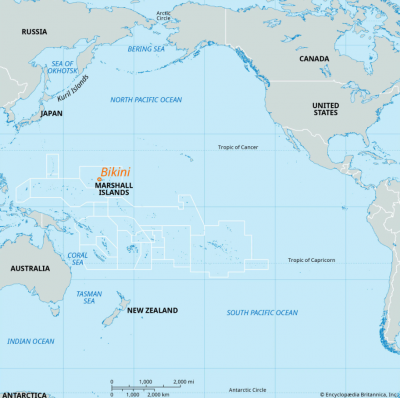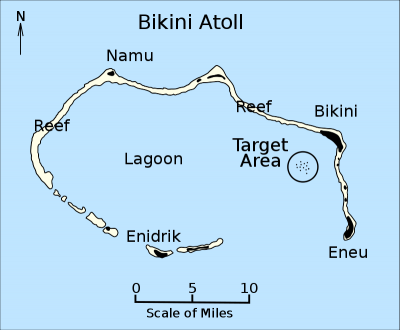The Impact of Military Activities on Reefs
How Islands Change When the Military Arrives
This is an area for future research.
Nuclear Testing
As a result of lingering tensions from both world wars, the United States and a multitude of European countries fell into a state of distress, which further motivated the widespread creation of more powerful weapons. The first atomic device was detonated in Alamo, Texas in 1945, marking the beginning of an arms race between the United States and Russia, which quickly spread to other countries such as The United Kingdom and France. This race for military supremacy and security resulted in globally significant advancements in weapon technology.
On July 25, 1946, the first nuclear ocean test was conducted under Operation Crossroads in The Bikini Atoll [2]. This area is a part of a larger chain of islands known as The Marshall Islands in the Pacific. This Atoll fit all of the military's requirements to be an ocean test sight: United States territory, 1,000 miles from a military base, and a small population that they could easily relocate [2].
The first test was a success, dropping the atomic bomb 90 feet below the surface level and creating massive destruction, especially to the surrounding reefs and ocean life. After this success, the Bikini Atoll became a popular place for detonations, with tests occurring again 23 times until 1958 [3].
The United States then tested the first hydrogen bomb on Eniwetok Atoll in 1952, just 190 miles west from Bikini Atoll. This launched Operation Ivy. 43 nuclear tests were conducted in the waters of Eniwetok Atoll [2].
As time continued, Britain and France joined the race and began conducting oceanic tests during the mid-to-late-twentieth century. In 1952, the British launched Operation Hurricane in Montebello Islands, followed by 12 more tests until 1958. France chose to test their weaponry in both Mururoa and Fangataufa Atolls between 1966 and 1996 [4].
Throughout testing, locals and government officials grew concerned about the potential destructive effects these weapons could cause. In 1958, there was a moratorium–a break from the testing–due to increased public opposition and hope that the United States could make peace with the Soviets (Bolton, 2018). This opposition sparked important discussions about test ban treaties, which came partly to fruition in August of 1963, when The Limited Nuclear Test Ban Treaty proposed by the United Nations was signed and ratified by the United States [5]. This treaty banned nuclear testing in the atmosphere, outer space, and under water. There are also some legal guidelines regarding underground testing, prohibiting explosions if "radioactive debris to be present outside the territorial limits of the State under whose jurisdiction or control," [6].
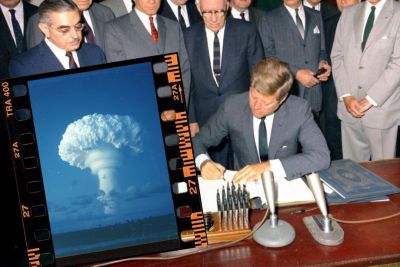

JFK Signing the Limited Nuclear Test Ban Treaty[7]
Overall, the United States, France, and the United Kingdom dropped 318 nuclear devices in the waters of the Pacific between 1946 and 1996. Despite having the treaty created in 1963, some countries such as France refused to sign until much later, prolonging the devastating reef destruction. Even now, it is suspected that countries conduct oceanic tests in private. Since 2023, Russia has been building up their Novaya Zemlya test site in the arctic ocean, preparing to continue the legacy of ocean ruination [5].
Ocean Testing
The primary goals of nuclear testing have evolved with time. Originally, these projects aimed for weapon effectiveness, refining critical elements, improving bomb designs, and ensuring the overall safety of the United States [8]. Oceanic testing, however, had very different and limited goals in mind. Oceanic testing refers to the nuclear detonations that took place underwater or near the surface of the water [9]. The objective of ocean nuclear testing was to study the bomb's effectiveness against marine vessels and regain national trust in the United States' naval fleet. The concept was originally proposed by Lewis Strauss, the future Chairman of the Atomic Energy Commission. In an internal memo with the secretary of the Navy, Lewis argued that "If such a test is not made, there will be loose talk to the effect that the fleet is obsolete in the face of this new weapon and this will militate against appropriations to preserve a postwar Navy of the size now planned," [10]. His fear of losing national support was due to the already low spirits of Americans after the massive destruction of Naval ships in 1921 by General Billy Mitchel, who sank every targeted navy ship in battle [11]. Strauss believed that proving the survivability of marine vessels against nuclear weapons would win back public opinion. With few bombs available, ships were spread throughout a large area, and the testing commenced. Operation Crossroads and Wigwam were the main two oceanic-related nuclear tests. Due to large amounts of radioactive waste contaminating water supplies and consequently damaging nearby ships, people, and other structures, Underwater nuclear testing was banned in the 1963 Limited Test Ban Treaty [9].
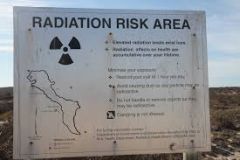

Radiation Risk Area sign in Montebello Islands[12]
Bomb Economy
The term "bomb economy" is from David Alexander Baker's "The Lost Continent" and is used to describe the effects of the military nuclear bases on the Pacific islands [13] This concept originated when the island of French Polynesia was converted from an exporter of vanilla, coffee, and phosphate into a nuclear testing program [14]. This transition consequently marked an economic boom for the islands and brought many people and resources to the islands. Airports and shipping ports were built on reclaimed reefs to support the transfer of people and goods into the area. These areas effectively created the basis of tourism infrastructure that is still around to this day [14]. After nuclear testing, the people on the French Polynesia islands were then encouraged to migrate to the islands of Tahiti and Moorea, where they would be able to escape the nuclear fallout and radiation that had been making them sick. Eventually, 70% of French Polynesia's population resided on these islands and the tourism economy was further expanded [14]. Since so many people were leaving traditional economic sectors to participate in these high-cash activities, the previously dominant small-scale agriculture department dwindled. In more recent, post-colonial times, the people of the island still feel the effects of forced migration. Since their economies are still heavily reliant on tourism, much of their income is threatened by natural disasters such as hurricanes and tsunamis, which continue to destroy the surrounding reefs. However, the main reason for their contemporary environmental problems is cited to be nuclear testing [14].
Case Study: Bikini Atoll
By the hand of the US Army, Bikini Atoll of Marshall Islands, located in the Central Pacific, underwent the largest thermonuclear weapons test to this day. 1000 times more powerful than the atomic weapon used on Hiroshima in 1945, March 1, 1954 marks the day the US Army wreaked havoc on these secluded islands. The explosion led to extensive impacts on the fringing coral reef, surrounding communities– including 4 different continents, and air quality, as the radioactive debris spread all the way into the stratosphere [16].
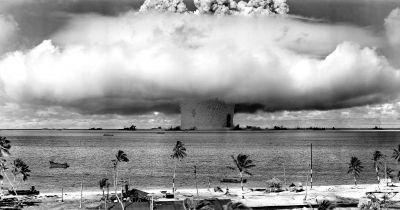

Atomic Bomb at Bikini Atoll[17]
Scientists have been able to use the radioactive debris to track/measure ocean currents. Radioactive tracers are synthetic derivatives of naturally occurring substances used to track the fallout from bomb testing [18]. In this case, the tracer was a heavier form of hydrogen called tritium, which was carried into higher altitudes and rained directly into oceans [19]. Since there is so little tritium on Earth, scientists have been able to track where and when the fallout tritium has entered the ocean, they can track its movement and further understand ocean currents. Fun fact: we now know that a single drop of water takes around 1,000 years to circulate through the entire ocean.
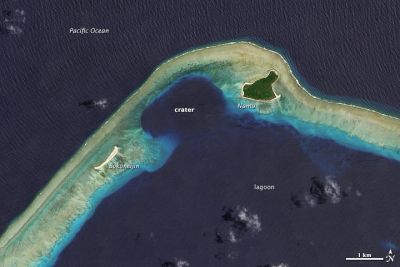

NASA Earth Observatory Image of Castle Bravo Crater in Bikini
Atoll[20]
Although tracers have turned out to be a helpful result of nuclear bomb testing, the testing itself was incredibly destructive, as we can see in Bikini Atoll. Due to being secluded from common air and sea routes, Bikini Atoll was chosen to be the US's testing spot for nuclear weaponry. The test on March 1, 1954, often nicknamed "Castle Bravo," resulted in a 2 km (or ~1.24 mile) wide & 73 meter deep crater, which destroyed the surrounding reefs and wiped out the previously-pristine biodiverse ecosystem [21]. Additionally, Castle Bravo raised the sea surface temperature to a shocking 55,000 degrees Celsius– which likely annihilated the surrounding marine life upon immediate impact. Although the primary reason for the test was to measure the weapon's magnitude of damage, scientists have taken this as an opportunity to measure how radiation affects marine life longevity. As time passes, radiation on Bikini Atoll has reduced enough for scientists to poke around, and the reefs seem to be thriving [21]. This is some impressive resilience, as the coral practically didn't exist after the blast 70 years ago. Teeming with fish and nearing almost full recovery of the coral species, the Bikini Atoll serves as a glimmer of hope for the future of coral, as its longevity gets tested every day.
The Potential Impacts of Nuclear Conflict on the Ocean
The remarkable resilience of Bikini Atoll has led scientists to question how some ecosystems flourish while many of the world's reefs are declining. Dr. Michael Webster, Executive Director of the Coral Reef Alliance, delineates that reefs are currently disappearing around the world due to higher temperatures, ocean acidification, overfishing, and pollution [21]. In isolation, none of these disturbances seem to be as detrimental as a destructive nuclear explosion. However, when the sum of the total effects of smaller, more frequent disturbances are compared to the effects of the isolated nuclear explosion at Bikini Atoll, it seems that reef resilience may be more dependent on frequency rather than magnitude [21].
In support of the previous findings, numerous physical, chemical, and biological processes in the ocean are also heavily reliant on temperature [22]. For this reason, the impacts that long-term disturbances, such as ocean acidification and rising seawater temperatures, have on marine ecosystems have been considerably examined. The American Geophysical Union (AGU) notes that since the preindustrial era, the ocean has cumulatively absorbed about 29% of the carbon dioxide emitted by human industrial activities [23]. Chemical reactions occurring between water and carbon dioxide fundamentally alter the oceans’ carbonate chemistry and cause rising seawater temperatures and ocean acidification. Consequently, decreasing seawater pH and calcium carbonate saturation states significantly negatively affect organisms that precipitate calcium carbonate shells and constitute significant threats to coral reefs [23].
Despite the resilience of Bikini Atoll, the reasonable possibility of future regional or global nuclear conflicts has led AGU to consider the impacts of potential nuclear explosions on reefs. Exactly how nuclear conflict will impact coral reefs has by no doubt been less studied than other marine ecosystem disturbances. Nevertheless, a group of AGU scientists found that soot injections from nuclear explosions cause changes in ocean light, temperature, and nutrients [23]. Intrigued by the ambiguity of previous studies, these scientists simulated the potential impacts of four nuclear conflict scenarios on ocean acidification using a state-of-the art Earth system model with varying amounts of soot injection [23].
The AGU scientists’ simulation showed that nuclear explosions caused sea surface temperature to decrease and dissolved inorganic carbon to increase in all four scenarios. They ultimately concluded that nuclear conflict would result in average surface ocean pH increasing and surface ocean calcium carbonate saturation decreasing [23]. It should be noted that initially this finding may be considered shocking because both variables typically decrease in typical anthropogenic ocean acidification scenarios [22]. However, the scientists explain that the opposing response to nuclear explosions is understood by considering seawater's carbonate chemistry system and sensitivity to changing temperature [23]. In any case, it is yet unknown exactly how coral reefs will be affected if future nuclear conflicts are to cause an abrupt increase in ocean pH. Specifically, whether and how organisms will respond to ocean pH decreasing since the beginning of the Industrial Revolution, followed by an immediate increase in the pH state is unknown [23]. However, it can be inferred that rapid and opposing changes in pH and levels of calcium concentration may have detrimental consequences for calcifying organisms. Since shell precipitation can be affected by the ambient hydrogen ion concentration in seawater, it is likely that nuclear conflict remains a contributing factor to the decline of coral reefs around the world [22].
References
- [↑ https://www.britannica.com/place/Bikini-atoll-Marshall-Islands]{#cite_note-britannica-1}
- [↑ 2.0 2.1 2.2 NMHB 2020 [Revised]. (2020). Www.acq.osd.mil. https://www.acq.osd.mil/ncbdp/nm/NMHB2020rev/chapters/chapter14.html]{#cite_note-nmhb-2}
- [↑ Webster, M. (2023, May 11). Naturally resilient. Smithsonian National Museum of National History. https://ocean.si.edu/ecosystems/coral-reefs/naturally-resilient]{#cite_note-smithsonian-3}
- [↑ British Nuclear Weapons Testing – Centre for Health Effects of Radiological and Chemical Agents (CHERCA). (n.d.). Centre for Health Effects of Radiological and Chemical Agents. Retrieved May 17, 2024, from https://chrc4veterans.uk/knowledge-hub/british-nuclear-weapons-testing/#:~:text=In%20the%201950s%20and%201960s]{#cite_note-british-4}
- [↑ 5.0 5.1 Bolton. (2018, May 7). Pacific Nuclear Test Archive | International Disarmament Institute News. Disarmament.blogs.pace.edu. https://disarmament.blogs.pace.edu/nuclear-test-archive/#:~:text=From%201946%20to%201996%2C%20the]{#cite_note-bolton-5}
- [↑ National Archives and Records Administration (NARA). (2022, February 8). Test ban treaty (1963). National Archives and Records Administration. https://www.archives.gov/milestone-documents/test-ban-treaty]{#cite_note-nara-6}
- [↑ https://diplomacy.state.gov/events-listing/60-years-limited-nuclear-test-ban-treaty/]{#cite_note-jfk-7}
- [↑ Environmental impacts of underground nuclear weapons testing. Bulletin of the Atomic Scientists. (2024, April 18). https://thebulletin.org/premium/2024-03/environmental-impacts-of-underground-nuclear-weapons-testing/]{#cite_note-ei-8}
- [↑ 9.0 9.1 United Nations. (n.d.). End nuclear tests day - history. United Nations. https://www.un.org/en/observances/end-nuclear-tests-day/history#:~:text=Underwater%20nuclear%20explosions%20close%20to,1963%20Partial%20Test%20Ban%20Treat]{#cite_note-un-9}
- [↑ Strauss, Lewis (1962), Men and Decisions, Garden City, New York: Doubleday https://www.unep.org/news-and-stories/story/environmental-legacy-explosive-weapons-populated-areas]{#cite_note-strauss-10}
- [↑ Weisgall, Jonathan (1994), Operation Crossroads: The Atomic Tests at Bikini Atoll, Annapolis, Maryland: Naval Institute Press]{#cite_note-weisgall-11}
- [↑ https://www.abc.net.au/news/2018-06-16/safety-concerns-on-the-montebello-islands/9855482]{#cite_note-abc-12}
- [↑ Baker, D. A. (2022). The Lost Continent: Coral Reef Conservation and Restoration in the Age of Extinction. United Kingdom: Charlesbridge.]{#cite_note-baker-13}
- [↑ 14.0 14.1 14.2 14.3 Walker, B.L.E., López-Carr, D., Chen, C. et al. Perceptions of environmental change in Moorea, French Polynesia: the importance of temporal, spatial, and scalar contexts. GeoJournal 79, 705–719 (2014). https://doi.org/10.1007/s10708-014-9548-8]{#cite_note-walker-14}
- [↑ https://en.wikipedia.org/wiki/File:Bikini_Atoll_Operation_Crossroads.svg]{#cite_note-wikimedia-15}
- [↑ Chirayath, V. (2016, March 7). Impacts of Nuclear Testing on Bikini Atoll Coral Reefs. Impacts of nuclear testing on Bikini Atoll coral reefs. http://large.stanford.edu/courses/2015/ph241/chirayath2/#:~:text=Apart%20from%20the%20physical%20vaporization,largely%20uninhabited%20and%20radioactively%20contaminated]{#cite_note-chirayath-16}
- [↑ https://www.history.com/news/nuclear-bomb-tests-bikini-atoll-facts]{#cite_note-history-17}
- [↑ Gutierrez, B. (2021, July 15). Why the U.S. once set off a nuclear bomb in space. Premium. https://www.nationalgeographic.com/premium/article/why-the-us-once-set-off-a-nuclear-bomb-in-space-called-starfish-prime]{#cite_note-gutierrez-18}
- [↑ Benningfield, D. (2016, May 8). Bomb tracers. Science and the Sea. https://www.scienceandthesea.org/program/201605/bomb-tracers]{#cite_note-benningfield-19}
- [↑ https://landsat.visibleearth.nasa.gov/view.php?id=83237]{#cite_note-nasa-20}
- [↑ 21.0 21.1 21.2 21.3 Webster, M. (2023, May 11). Naturally resilient. Smithsonian National Museum of National History. https://ocean.si.edu/ecosystems/coral-reefs/naturally-resilient]{#cite_note-webster-21}
- [↑ 22.0 22.1 22.2 National Science Foundation. (2018, January 29). Scientists pinpoint how ocean acidification weakens coral skeletons. NSF. https://new.nsf.gov/news/scientists-pinpoint-how-ocean-acidification#:~:text=The%20analysis%20revealed%20that%20the,upward%20growth%2C%20but%20thickening%20suffers]{#cite_note-nsf-22}
- [↑ 23.0 23.1 23.2 23.3 23.4 23.5 23.6 Lovenduski, N. (2020, January). The potential impact of nuclear conflict on ocean acidification. Geographical Research Letters. https://agupubs.onlinelibrary.wiley.com/doi/10.1029/2019GL086246]{#cite_note-lovenduski-23}
